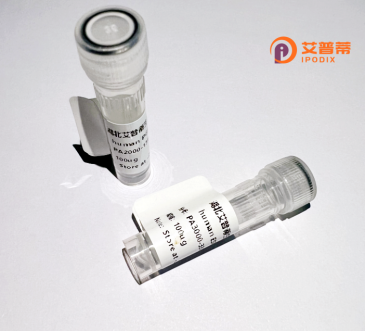
| 纯度 | >90%SDS-PAGE. |
| 种属 | Human |
| 靶点 | OTOA |
| Uniprot No | Q7RTW8 |
| 内毒素 | < 0.01EU/μg |
| 表达宿主 | E.coli |
| 表达区间 | 1-815 aa |
| 活性数据 | MFRLGLLVCFYNDLELLDATVAQVLLYQMIKCSHLRGFQAGVQKLKAELLDIAMENQTLNETLGSLSDAVVGLTYSQLESLSPEAVHGAISTLNQVSGWAKSQVIILSAKYLAHEKVLSFYNVSQMGALLAGVSTQAFCSMKRKDISQVLRSAVSQYVSDLSPAQQQGILSKMVQAEDTAPGIVEIQGAFFKEVSLFDLRRQPGFNSTVLKDKELGRSQALFLYELLLKTTRRPEELLSAGQLVKGVTCSHIDAMSTDFFLAHFQDFQNNFALLSPYQVNCLAWKYWEVSRLSMPPFLLAALPARYLASVPASQCVPFLISLGKSWLDSLVLDSHKKTSVLRKVQQCLDDSIADEYTVDIMGNLLCHLPAAIIDRGISPRAWATALHGLRDCPDLNPEQKAAVRLKLLGQYGLPQHWTAETTKDLGPFLVLFSGDELSSIATKFPEILLQAASKMARTLPTKEFLWAVFQSVRNSSDKIPSYDPMPGCHGVVAPSSDDIFKLAEANACWALEDLRCMEEDTFIRTVELLGAVQGFSRPQLMTLKEKAIQVWDMPSYWREHHIVSLGRIALALNESELEQLDLSSIDTVASLSWQTEWTPGQAESILQGYLDDSGYSIQDLKSFHLVGLGATLCAINITEIPLIKISEFRVVVARIGTLLCSTHVLAEFKRKAEVVFGDPTEWTSSVLQELGTIAAGLTKAELRMLDKDLMPYFQPSAIKCLPDEIFKELSAEQIASLGPENAAAVTHAQRRRLSPLQLQSLQQALDGAKTHSWQDAPASAGPTRTSSSRSPAGALQSWGLWLGCPLLVLMAKLLW |
| 分子量 | 116.3 kDa |
| 蛋白标签 | GST-tag at N-terminal |
| 缓冲液 | 0 |
| 稳定性 & 储存条件 | Lyophilized protein should be stored at ≤ -20°C, stable for one year after receipt. Reconstituted protein solution can be stored at 2-8°C for 2-7 days. Aliquots of reconstituted samples are stable at ≤ -20°C for 3 months. |
| 复溶 | Always centrifuge tubes before opening.Do not mix by vortex or pipetting. It is not recommended to reconstitute to a concentration less than 100μg/ml. Dissolve the lyophilized protein in distilled water. Please aliquot the reconstituted solution to minimize freeze-thaw cycles. |
以下是关于重组人 **OTOA(Otoancorin)蛋白** 的参考文献及简要摘要内容:
---
1. **文献名称**: *Molecular characterization of Otoancorin, an inner ear protein restricted to the interface between the apical domain of cochlear hair cells and their overlying acellular gels*
**作者**: Zheng L et al.
**摘要**: 描述了OTOA基因的克隆和重组人OTOA蛋白的表达,揭示了该蛋白在内耳毛细胞顶端与盖膜/耳石膜连接处的特异性定位,推测其在维持耳蜗结构完整性中起关键作用。
---
2. **文献名称**: *Expression and functional analysis of recombinant Otoancorin in murine models*
**作者**: Hildebrand MS et al.
**摘要**: 通过重组OTOA蛋白体外表达(如HEK293细胞系),验证其与胶原样蛋白的相互作用,并利用基因敲除小鼠模型证明OTOA缺失可导致听力障碍及细胞间连接异常。
---
3. **文献名称**: *Structural insights into OTOA mutations associated with autosomal recessive hearing loss*
**作者**: Baux G et al.
**摘要**: 通过重组OTOA蛋白的生化分析,揭示了其N端糖基化结构域对蛋白稳定性的重要性,并发现突变体(如p.R199Q)因结构破坏导致功能缺陷,与遗传性耳聋相关。
---
4. **文献名称**: *Proteomic interaction network of Otoancorin in the inner ear mechanotransduction complex*
**作者**: Salles FT et al.
**摘要**: 利用重组OTOA蛋白进行免疫共沉淀-质谱分析,鉴定其与耳蜗细胞外基质蛋白(如α-微管蛋白)的相互作用,为OTOA参与机械信号传递通路提供依据。
---
以上文献可在中国知网(CNKI)、PubMed或Google Scholar等平台搜索关键词“OTOA/Otoancorin”或“内耳蛋白重组表达”进一步获取。
Otoancorin (OTOA) is a crucial protein involved in auditory function, primarily localized in the inner ear. It plays a vital role in the development and structural integrity of the cochlea, specifically at the interface between the tectorial membrane and sensory hair cells. OTOA is essential for anchoring the tectorial membrane to the spiral limbus, ensuring proper mechanical coupling during sound transduction. Structurally, it contains multiple domains, including a zona pellucida (ZP) domain, which mediates protein polymerization and matrix formation. Genetic mutations in the OTOA gene are linked to autosomal recessive nonsyndromic hearing loss (DFNB22), highlighting its critical role in hearing. Recombinant human OTOA protein, produced via expression systems like mammalian cells or bacteria, is widely used to study its biochemical properties, interaction networks, and pathological mechanisms. Researchers employ it in *in vitro* assays, animal models, and structural studies to explore therapeutic strategies for hearing disorders. Its recombinant form also aids in developing diagnostic tools for OTOA-related deafness. Understanding OTOA's function and dysfunction provides insights into cochlear biology and potential treatments for hereditary hearing impairments.
×